Garage Door Monitor and Opener
Dependencies: X_NUCLEO_COMMON ST_INTERFACES
Introduction
This system implements a simple garage door opener and environmental monitor. The hardware connects to the internet using Wi-Fi then on to the Pelion Device Management Platform which provides device monitoring and secure firmware updates over the air (FOTA). Pelion Device Management provides a flexible set of REST APIs which we will use to communicate to a web application running on an EC-2 instance in AWS. The web application will serve a web page where we can monitor and control our garage..
This project is intended to work on the DISCO-L475VG-IOT01A from ST Microelectronics It implements a simple actuator to drive a relay to simulate pushing the "open" button on older style garage doors which do not use a rolling code interface.
The system is designed to be mounted over the door so that the on board time of flight sensor can be used to detect if the door is open or closed.
The system also monitors temperature, humidity and barometric pressure.
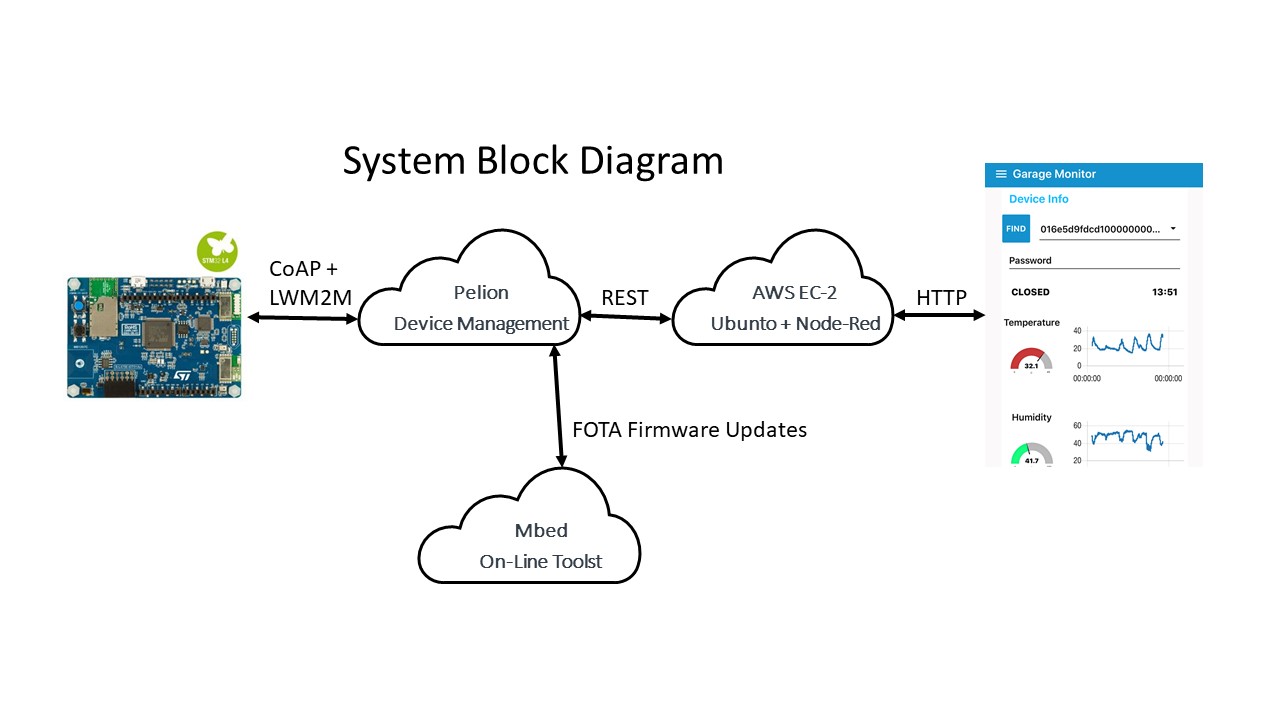
Hardware Requirements:
DISCO-L475G-IOT01A https://os.mbed.com/platforms/ST-Discovery-L475E-IOT01A/
Seeed Studio Grove Relay module https://www.seeedstudio.com/Grove-Relay.html
Seeed Studio Grove cable, I used this one: https://www.seeedstudio.com/Grove-4-pin-Male-Jumper-to-Grove-4-pin-Conversion-Cable-5-PCs-per-Pack.html
Connect to the PMOD connector like this:

This shows how I installed so that the time of flight sensor can detect when the door is open
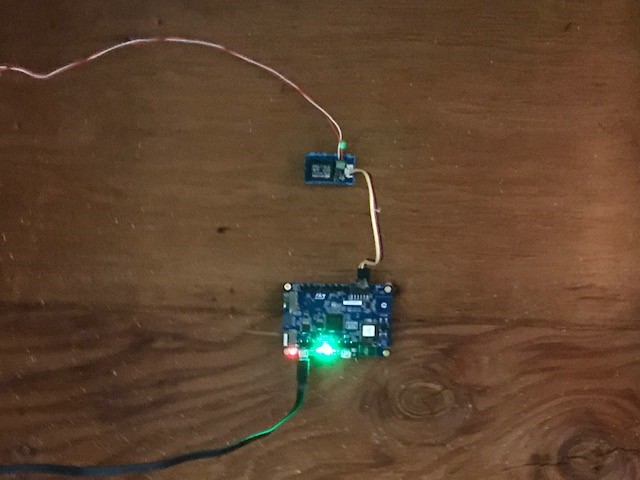
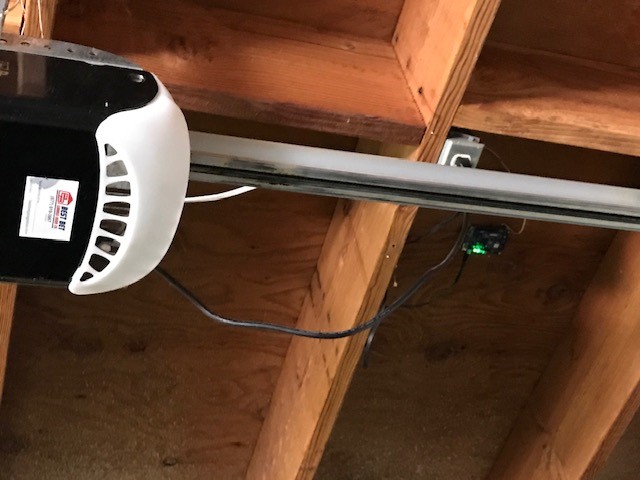
To use the project:
You will also need a Pelion developers account.
I suggest you first use the Pelion quick state to become familiar with Pelion Device Management. https://os.mbed.com/guides/connect-device-to-pelion/1/?board=ST-Discovery-L475E-IOT01A
Web Interface
For my web interface I am running node-red under Ubuntu in an EC2 instance on AWS. This can run for 12 month within the constraints of their free tier. Here is a tutorial: https://nodered.org/docs/getting-started/aws
You will also need to install several node-red add ons:
sudo npm install -g node-red-dashboard
sudo npm install -g node-red-contrib-mbed-cloud
sudo npm istall -g node-red-contrib-moment
After starting node-red import the contents of GarageFlow.txt from the project, pin the flow into the page.
To enable your web app to access your Pelion account you need an API key.
First you will neet to use your Pelion account to create an API key.
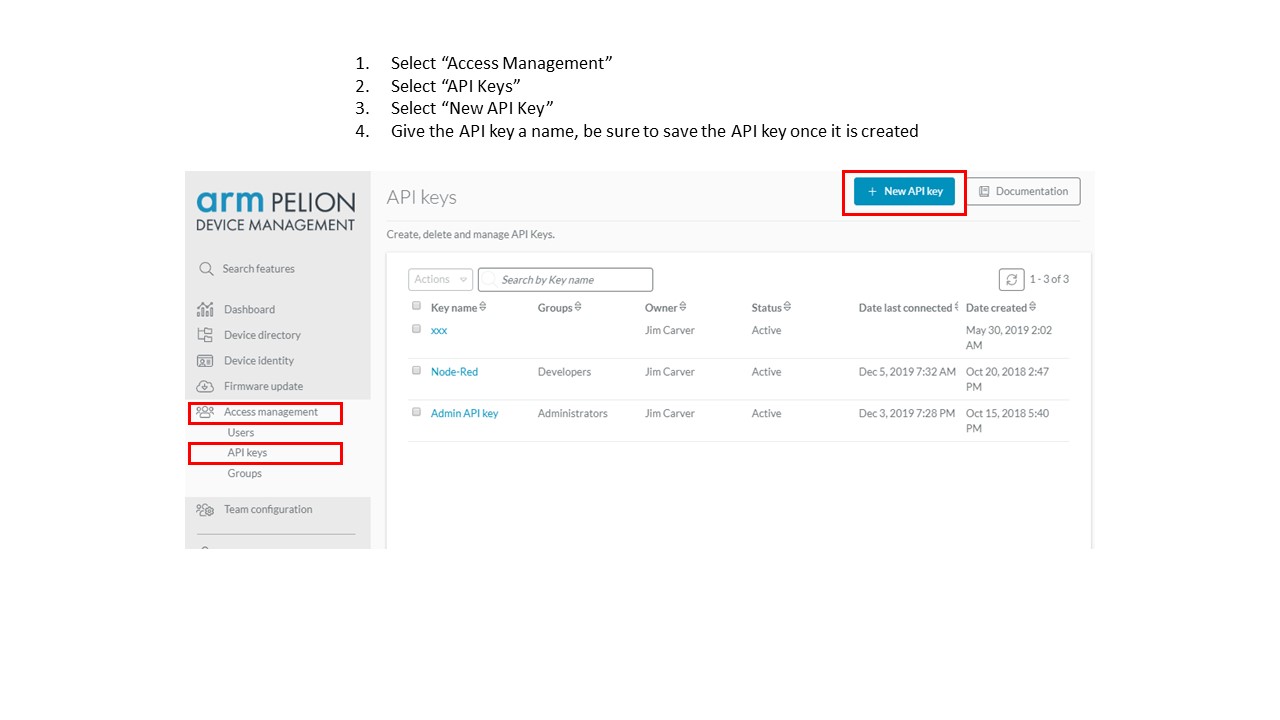
Now we need to apply that API key to your Node-Red flow.
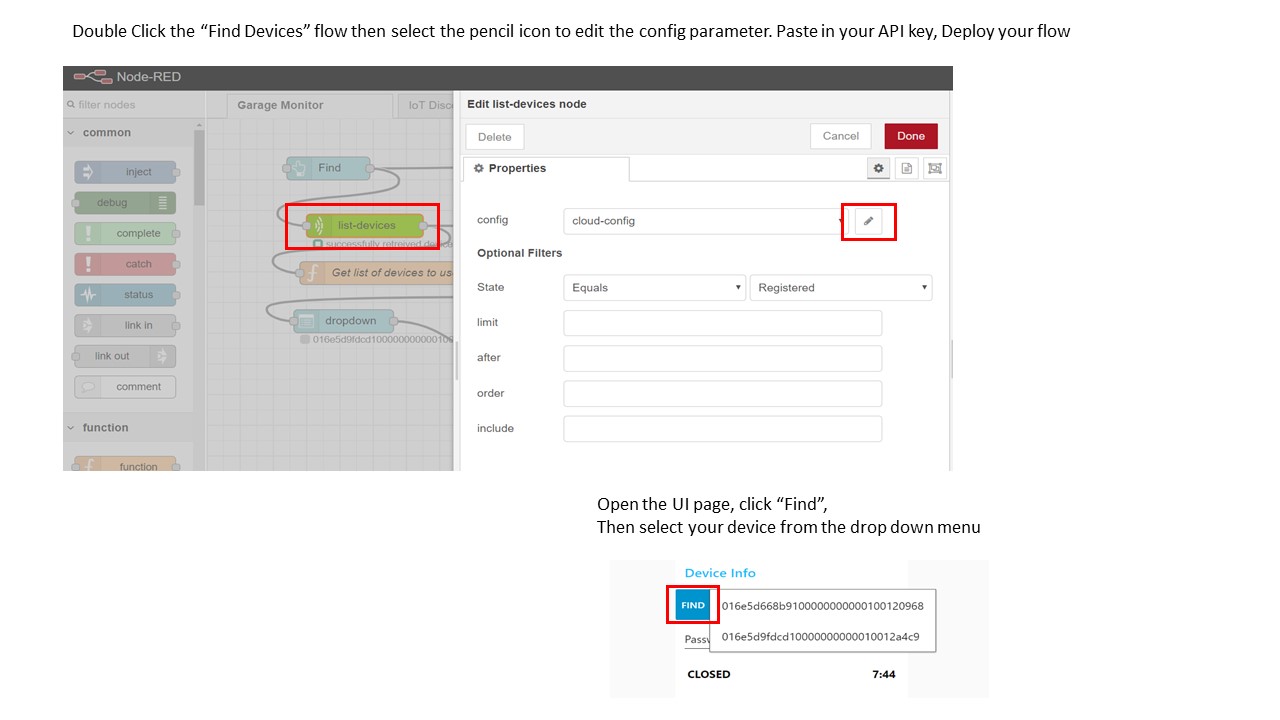
sensors/LIS3MDL/lis3mdl_class.h
- Committer:
- JimCarver
- Date:
- 2019-12-05
- Revision:
- 37:ec1124e5ec1f
- Parent:
- 18:a15bfe7aaebd
File content as of revision 37:ec1124e5ec1f:
/**
******************************************************************************
* @file lis3mdl_class.h
* @author AST / EST
* @version V0.0.1
* @date 14-April-2015
* @brief Header file for component LIS3MDL
******************************************************************************
* @attention
*
* <h2><center>© COPYRIGHT(c) 2015 STMicroelectronics</center></h2>
*
* Redistribution and use in source and binary forms, with or without modification,
* are permitted provided that the following conditions are met:
* 1. Redistributions of source code must retain the above copyright notice,
* this list of conditions and the following disclaimer.
* 2. Redistributions in binary form must reproduce the above copyright notice,
* this list of conditions and the following disclaimer in the documentation
* and/or other materials provided with the distribution.
* 3. Neither the name of STMicroelectronics nor the names of its contributors
* may be used to endorse or promote products derived from this software
* without specific prior written permission.
*
* THIS SOFTWARE IS PROVIDED BY THE COPYRIGHT HOLDERS AND CONTRIBUTORS "AS IS"
* AND ANY EXPRESS OR IMPLIED WARRANTIES, INCLUDING, BUT NOT LIMITED TO, THE
* IMPLIED WARRANTIES OF MERCHANTABILITY AND FITNESS FOR A PARTICULAR PURPOSE ARE
* DISCLAIMED. IN NO EVENT SHALL THE COPYRIGHT HOLDER OR CONTRIBUTORS BE LIABLE
* FOR ANY DIRECT, INDIRECT, INCIDENTAL, SPECIAL, EXEMPLARY, OR CONSEQUENTIAL
* DAMAGES (INCLUDING, BUT NOT LIMITED TO, PROCUREMENT OF SUBSTITUTE GOODS OR
* SERVICES; LOSS OF USE, DATA, OR PROFITS; OR BUSINESS INTERRUPTION) HOWEVER
* CAUSED AND ON ANY THEORY OF LIABILITY, WHETHER IN CONTRACT, STRICT LIABILITY,
* OR TORT (INCLUDING NEGLIGENCE OR OTHERWISE) ARISING IN ANY WAY OUT OF THE USE
* OF THIS SOFTWARE, EVEN IF ADVISED OF THE POSSIBILITY OF SUCH DAMAGE.
*
******************************************************************************
*/
#ifndef __LIS3MDL_CLASS_H
#define __LIS3MDL_CLASS_H
/* Includes ------------------------------------------------------------------*/
#include "mbed.h"
#include "DevI2C.h"
#include "lis3mdl.h"
#include "MagneticSensor.h"
#include <assert.h>
/* Classes -------------------------------------------------------------------*/
/** Class representing a LIS3MDL sensor component
*/
class LIS3MDL : public MagneticSensor {
public:
enum SPI_type_t {SPI3W, SPI4W};
LIS3MDL(SPI *spi, PinName cs_pin, PinName int_pin=NC, SPI_type_t spi_type=SPI4W);
/** Constructor
* @param[in] i2c device I2C to be used for communication
*/
LIS3MDL(DevI2C *i2c, uint8_t address=LIS3MDL_M_MEMS_ADDRESS_HIGH, PinName int_pin=NC);
/** Destructor
*/
virtual ~LIS3MDL() {}
/*** Interface Methods ***/
virtual int init(void *init_struct) {
return LIS3MDL_Init((MAGNETO_InitTypeDef*)init_struct);
}
virtual int read_id(uint8_t *m_id) {
return LIS3MDL_Read_M_ID(m_id);
}
virtual int get_m_axes(int32_t *pData) {
return LIS3MDL_M_GetAxes(pData);
}
virtual int get_m_axes_raw(int16_t *pData) {
return LIS3MDL_M_GetAxesRaw(pData);
}
protected:
/*** Methods ***/
MAGNETO_StatusTypeDef LIS3MDL_Init(MAGNETO_InitTypeDef *LIS3MDL_Init);
MAGNETO_StatusTypeDef LIS3MDL_Read_M_ID(uint8_t *m_id);
MAGNETO_StatusTypeDef LIS3MDL_M_GetAxes(int32_t *pData);
MAGNETO_StatusTypeDef LIS3MDL_M_GetAxesRaw(int16_t *pData);
MAGNETO_StatusTypeDef LIS3MDL_Set_SpiInterface (void *handle, LIS3MDL_SPIMode_t spimode);
/**
* @brief Configures LIS3MDL interrupt lines for NUCLEO boards
*/
void LIS3MDL_IO_ITConfig(void)
{
/* To be implemented */
}
/**
* @brief Configures LIS3MDL I2C interface
* @return MAGNETO_OK in case of success, an error code otherwise
*/
MAGNETO_StatusTypeDef LIS3MDL_IO_Init(void)
{
return MAGNETO_OK; /* done in constructor */
}
/**
* @brief Utility function to read data from LIS3MDL
* @param[out] pBuffer pointer to the byte-array to read data in to
* @param[in] RegisterAddr specifies internal address register to read from.
* @param[in] NumByteToRead number of bytes to be read.
* @retval MAGNETO_OK if ok,
* @retval MAGNETO_ERROR if an I2C error has occured
*/
MAGNETO_StatusTypeDef LIS3MDL_IO_Read(uint8_t* pBuffer,
uint8_t RegisterAddr, uint16_t NumByteToRead)
{
if (_dev_spi) {
/* Write Reg Address */
_dev_spi->lock();
_cs_pin = 0;
if (_spi_type == SPI4W) {
_dev_spi->write(RegisterAddr | 0x80);
for (int i=0; i<NumByteToRead; i++) {
*(pBuffer+i) = _dev_spi->write(0x00);
}
} else if (_spi_type == SPI3W){
/* Write RD Reg Address with RD bit*/
uint8_t TxByte = RegisterAddr | 0x80;
_dev_spi->write((char *)&TxByte, 1, (char *)pBuffer, (int) NumByteToRead);
}
_cs_pin = 1;
_dev_spi->unlock();
return MAGNETO_OK;
}
if (!_dev_i2c) return MAGNETO_ERROR;
int ret = _dev_i2c->i2c_read(pBuffer,
_address,
RegisterAddr,
NumByteToRead);
if(ret != 0) {
return MAGNETO_ERROR;
}
return MAGNETO_OK;
}
/**
* @brief Utility function to write data to LIS3MDL
* @param[in] pBuffer pointer to the byte-array data to send
* @param[in] RegisterAddr specifies internal address register to read from.
* @param[in] NumByteToWrite number of bytes to write.
* @retval MAGNETO_OK if ok,
* @retval MAGNETO_ERROR if an I2C error has occured
*/
MAGNETO_StatusTypeDef LIS3MDL_IO_Write(uint8_t* pBuffer,
uint8_t RegisterAddr, uint16_t NumByteToWrite)
{
if (_dev_spi) {
_dev_spi->lock();
_cs_pin = 0;
int data = _dev_spi->write(RegisterAddr);
_dev_spi->write((char *)pBuffer, (int) NumByteToWrite, NULL, 0);
_cs_pin = 1;
_dev_spi->unlock();
return MAGNETO_OK;
}
if (!_dev_i2c) return MAGNETO_ERROR;
int ret = _dev_i2c->i2c_write(pBuffer, _address, RegisterAddr, NumByteToWrite);
if(ret != 0) {
return MAGNETO_ERROR;
}
return MAGNETO_OK;
}
/*** Instance Variables ***/
/* IO Device */
DevI2C *_dev_i2c;
SPI *_dev_spi;
uint8_t _address;
DigitalOut _cs_pin;
InterruptIn _int_pin;
SPI_type_t _spi_type;
};
#endif // __LIS3MDL_CLASS_H